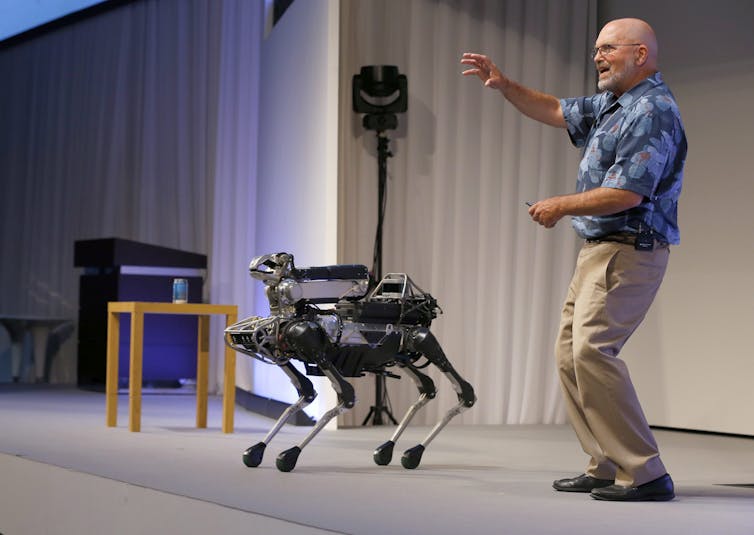Are we ready for the digital tsunami?
Technology and artificial intelligence are already profoundly changing how we live, work and travel. Are we ready for more profound changes? (Shutterstock)
Sylvie Albert, University of Winnipeg
How do we prepare for and manage what’s known as the Fourth Industrial Revolution?
A technological metamorphosis is upon us, and we need to do more than look behind and use digital technologies to fix historical problems. We must start thinking more innovatively about how we re-engineer communities, moving from smart (where we use individual tools and technologies to fix problems) to intelligent (where we plan on using disruption to our advantage).
The recent debate over the Google/Sidewalk Labs proposals for the city of Toronto is an example of how quickly digitalization is moving forward — and how unprepared we are to answer some important questions.
Here are some critical issues:
Open data
With more data from the Internet of Things (IoT), how will we make use of the information? Data is an asset that must be managed as a valued resource, not only by companies for use and resale, but for its public good and its opportunity to spur new social and economic innovations.
A recent Smart Cities World article outlined some good examples on improvements we could make. The combination of several sources of data can make a significant difference in bringing about new solutions to a host of problems, from forecasting floods to minimizing medical wait times and preventing crime.
Open data needs management principles and procedures — ownership decisions and intellectual property (IP) rights, safe uses and protection, and compatible systems based on common standards to combine several data sets from different organizations in order to make inferences about that information.
This will force engagement and partnerships among the public sector, private sector, non-profits and citizens to make principled decisions.
Communities are at the centre of this planning, and have resources they can use to help — the European Commission, for example, has published a toolkit for data managers and data holders. And a Canadian public interest law clinic (CIPPIC) provides an FAQ on smart cities that contains valuable legal information.
Ownership and protection of personal information, as well as privacy issues, are key points of contention. But let’s remember that not all data are sensitive and require deep contemplation about usage. There are models for dealing with contentious issues, such as those proposed in a playbook provided by Harvard to cities wanting to share data.
Artificial intelligence and robotics
AI and robots will continue to replace humans. We’re already experiencing downsizing in some disciplines and demand for new types of skills, or more of the skills needed for the digital revolution. The ability to use AI to help us make decisions, to serve customers and perform repetitive tasks will continue to dramatically alter the workplace.
Post-secondary programs will need to change — some currently popular programs may have fewer job offerings, while other fields, or an amalgamation of disciplines, will need to be created or emphasized. Learning more than one discipline and honing up on soft skills (such as in communications, innovation and problem solving) will be key for many graduates.

The shifts in employment could hit some communities harder than others. Therefore it’s more important than ever to think ahead and determine how the new digital economy might have an impact on the future of each community, and understand that the lifespan of some companies is now shorter.
Autonomous vehicles are evolving, perhaps slowly in some jurisdictions, but more actively in others. Legislation in the United States on self-driving vehicles is an example of how governments are grappling with the issues raised by driverless cars.
It causes some rethinking on insurance, new forms of ownership and entrepreneurship and a reassessment of planning for parking and land use. Vehicle manufacturers have been including more technologies in cars, inching our way to autonomous systems.
According to Deloitte, consumers may not be willing to pay for more technology in cars, but new ownership systems and ride-hailing services offer cost savings), cut down accidents by as much as 90 per cent and provide efficiencies that may accelerate consumer adoption.
More than 33 industries will be affected by the advent of driverless cars, according to CB Insights. Communities need to envision how they plan for the resulting opportunities and disruptions.
Envisioning the smart city
Regarding smart cities, we need more active community engagement in debating the pros and cons, in thinking about the impediments to change and how to implement what we believe will benefit citizens. These kinds of disruptions cannot be managed by governments alone; they require a wide variety of stakeholders at the table planning for change.
There are several interesting ideas floating around on future cities. We have an opportunity to think about doing things differently, and correctly, rather than repeating the same patterns.
In Barcelona, for example, community activists are working on a fabrication city concept. They describe it as:
“A step away from importing most things into the city and exporting our waste, and instead introducing a circular model, where all resources flow in a closed-loop system within the city itself.”
3D printing shops will be able to fabricate refrigerators and and cars with designs uploaded from the cloud. The question that must be answered: What changes would we need to make locally to allow this to happen?
Other examples are cities that focus on food production to improve their own food security; cities that are reducing CO2 and improving quality of life by becoming more walkable or more attractive for telecommuters.
This is only the start. There are many other ways that digitalization will impact sectors that affect where and how we live. Health care, for example, will undergo tremendous change as we self-manage, choose implantable technologies and cell and tissue regenerative technologies, and live longer lives.
We must think about the impact of these changes before we start building infrastructure that may no longer be needed in a few years.
Technology is already changing how we live our lives and go about our days. Are we ready with collaborative planning processes so we are not taken by surprise?
Sylvie Albert, Professor and past Dean, Faculty of Business & Economics, University of Winnipeg
This article is republished from The Conversation under a Creative Commons license. Read the original article.







